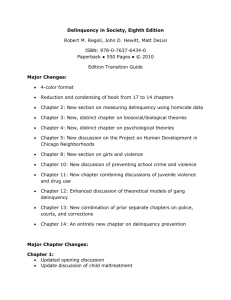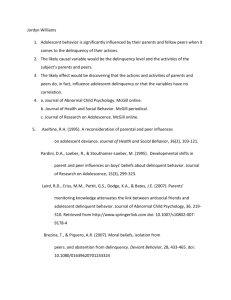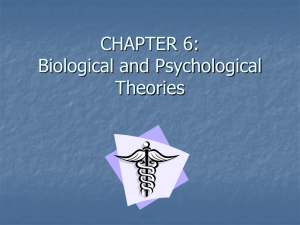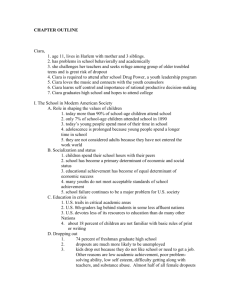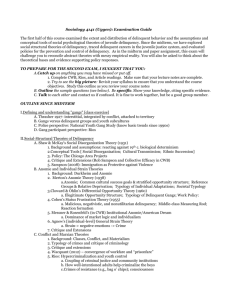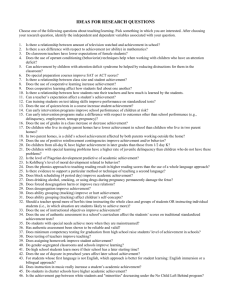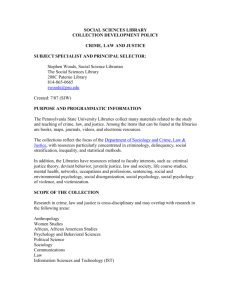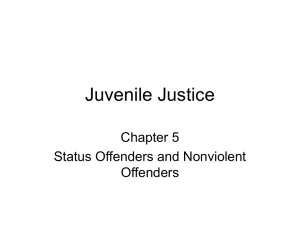Definitional Approaches to the Field of Criminology
advertisement
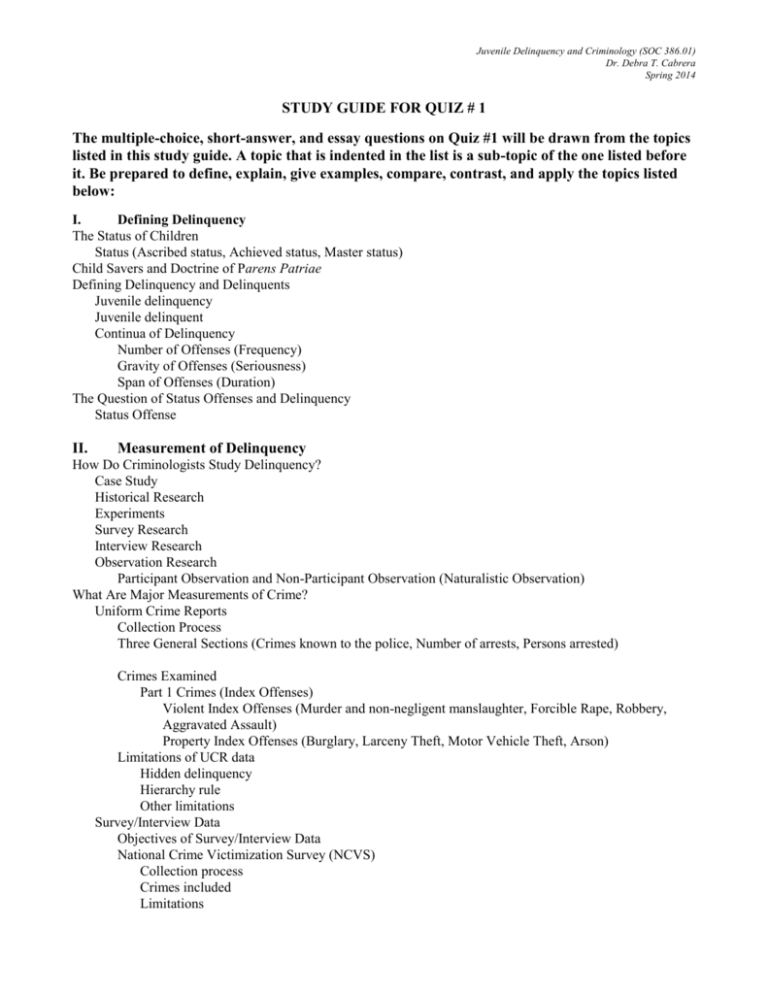
Juvenile Delinquency and Criminology (SOC 386.01) Dr. Debra T. Cabrera Spring 2014 STUDY GUIDE FOR QUIZ # 1 The multiple-choice, short-answer, and essay questions on Quiz #1 will be drawn from the topics listed in this study guide. A topic that is indented in the list is a sub-topic of the one listed before it. Be prepared to define, explain, give examples, compare, contrast, and apply the topics listed below: I. Defining Delinquency The Status of Children Status (Ascribed status, Achieved status, Master status) Child Savers and Doctrine of Parens Patriae Defining Delinquency and Delinquents Juvenile delinquency Juvenile delinquent Continua of Delinquency Number of Offenses (Frequency) Gravity of Offenses (Seriousness) Span of Offenses (Duration) The Question of Status Offenses and Delinquency Status Offense II. Measurement of Delinquency How Do Criminologists Study Delinquency? Case Study Historical Research Experiments Survey Research Interview Research Observation Research Participant Observation and Non-Participant Observation (Naturalistic Observation) What Are Major Measurements of Crime? Uniform Crime Reports Collection Process Three General Sections (Crimes known to the police, Number of arrests, Persons arrested) Crimes Examined Part 1 Crimes (Index Offenses) Violent Index Offenses (Murder and non-negligent manslaughter, Forcible Rape, Robbery, Aggravated Assault) Property Index Offenses (Burglary, Larceny Theft, Motor Vehicle Theft, Arson) Limitations of UCR data Hidden delinquency Hierarchy rule Other limitations Survey/Interview Data Objectives of Survey/Interview Data National Crime Victimization Survey (NCVS) Collection process Crimes included Limitations Juvenile Delinquency and Criminology (SOC 386.01) Dr. Debra T. Cabrera Spring 2014 Offender Self-Reports (OSR) Survey Data Limitations Calls for Service Advantages Disadvantages The Picture of Delinquents According to UCR, NCVS, and OSR Sex/Gender and Delinquency Race/Ethnicity and Delinquency Social Class and Delinquency Age and Delinquency Aging-out phenomenon Merton’s Anomie Comaprison with Durkheim’s Anomie Individual Modes of Adaptation Conformity Ritualism Retreatism Innovation Rebellion Evaluation of Theory Biological and Psychological Theories The “Atavistic Girl” The “Inferior Girl” The “Deceitful Girl” The “Delinquent Girl” Sociological Theories Female Delinquency and Merton’s Anomie/Strain Theory Female Delinquency and Status Frustration Marxist-Feminist Theories Power –Control Theory (Patriarchal Families and Egalitarian Families) Liberation Hypothesis Differential Oppression Theory Doubly Oppressed Adaptive Reactions Passive acceptance of one’s status Manipulation of peers to gain power Exercise of illegitimate coercive power Retaliation Evaluation of Theories Listed Juvenile Justice and Female Delinquency The Chivalry Hypothesis Policy Applications for Female Delinquency Routine Activities Theory Basic Assumptions Three Necessary Components for Criminal Opportunity (Motivated offenders, Suitable targets, Lack of Capable guardians) Juvenile Delinquency and Criminology (SOC 386.01) Dr. Debra T. Cabrera Spring 2014 Biological Positivism Foundational Work Cesare Lombroso’s The Criminal Man atavistic stigmata William Sheldon’s Somatotypes Endomorphy, mesomorphy, ectomorphy Critique Twins and Adoption Studies Monozygotic twins, dizygotic twins, and concordance Sugar and Crime Premenstrual Syndrome Tumors Chemical Poisoning Evaluation of Biological Theories Psychological Positivism IQ and Crime/Delinquency Psychoanalytic Theory Three Structures or Parts of the Personality (Id, Ego, Superego) Behavioral Theory (Imitation, Modeling, and the Media) Juvenile Justice Policy Implications of Biological and Psychological Positivism Differential Reinforcement Theory (Social Learning Theory) and Four Major Concepts Differential Association Theory (Nine Different Principles) Possible Essay Questions 1. Dr. Taitano is a criminologist who would like to study why some juveniles engage in theft. Describe how Dr. Taitano should carry out the research using two different methods: 1) participantobservation method and the 2) survey research method. Which method do you think will give Dr. Taitano more accurate information? Explain 2. Discuss three separate limitations of the Uniform Crime Reports. Include in your discussion the limitations of hidden delinquency and the hierarchy rule. How are Calls for Service different from Uniform Crime Reports? Which one do you think is the most accurate measurement of crime? Explain. 3. Discuss the relationship between ethnicity and crime/delinquency according the Uniform Crime Reports and the Offender Self Reports. What does each say about the ethnicity of the offenders? What do you think explains the different pictures that emerge from these two measurements of crime? 4. Choose a theory that you think best explains the case below. Discuss the arguments of the theory and describe how it can explain this particular case, and how it fails to explain certain aspects of the case. Also, discuss this theory's general weaknesses or limitations. [Dr. Cabrera will provide the case at the time of the quiz.] Juvenile Delinquency and Criminology (SOC 386.01) Dr. Debra T. Cabrera Spring 2014

